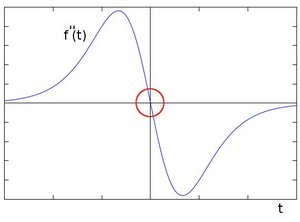 |
OpenCV 4.13.0-dev
Open Source Computer Vision
|
Loading...
Searching...
No Matches
 |
OpenCV 4.13.0-dev
Open Source Computer Vision
|
Prev Tutorial: Sobel Derivatives
Next Tutorial: Canny Edge Detector
| Original author | Ana Huamán |
| Compatibility | OpenCV >= 3.0 |
In this tutorial you will learn how to:


You can observe that the second derivative is zero! So, we can also use this criterion to attempt to detect edges in an image. However, note that zeros will not only appear in edges (they can actually appear in other meaningless locations); this can be solved by applying filtering where needed.
The Laplacian operator is defined by:
\[Laplace(f) = \dfrac{\partial^{2} f}{\partial x^{2}} + \dfrac{\partial^{2} f}{\partial y^{2}}\]

